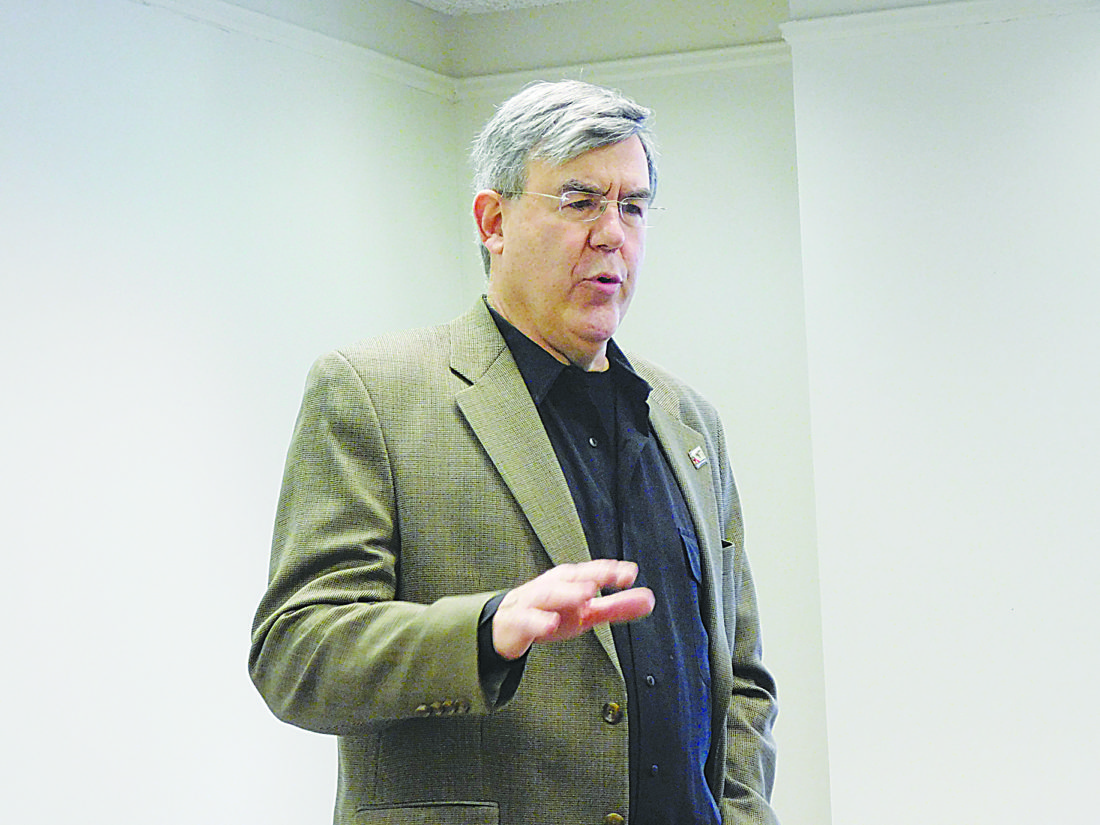WWI hero George Mallon subject of history lesson

Staff photo by Clay Schuldt Steven Chicoine gave a lunchtime seminar on WWI hero George H. Mallon at the Brown County Museum Annex. Chicoine has done in-depth research on veterans serving in every American war from the Civil War to Vietnam.
NEW ULM — The Brown County Historical Society kicked off its World War I speaking series with a lunchtime seminar on WWI Medal of Honor recipient George H. Mallon.
Historian Steven Chicoine recounted the life and times of Mallon to a crowd at the Brown County Museum Annex.
Mallon is one of the best-known Medal of Honor recipients from Minnesota. He was the first man to be buried at Fort Snelling National Cemetery.
Chicoine said Mallon is well-known for his war record, but he also led a fascinating life after the war.
Mallon was born in Kansas in 1877, and by the time of the Spanish-American War, he was old enough to enlist in the 22nd Kansas Volunteer Infantry. Mallon re-enlisted in the regular US Army in the 12th US Infantry Regiment and fought in the Philippines where he saw significant combat.
One of the more interesting facts Chicoine was able to uncover about Mallon’s time in the Philippines was his background in boxing. According to newspaper articles, Mallon had won the title of boxing champion of the Philippines islands. Chicoine is still researching how Mallon received the title and whether it was only a regimental honor, but his ability to deliver a punch would play a role in his earning the Medal of Honor.
After being discharged from the service, Mallon moved to Minneapolis and began to work installing sprinkler systems in buildings. Not long after, he became involved in the Labor Movement.
“Bear in mind, we’re not in 2017” Chicoine said. “In 1913, if you are in a labor union, you are a radical.”
Mallon was very outspoken in politics and was a strong supporter of labor rights.
In 1916, the Socialist candidate Thomas Van Lear was elected Mayor of Minneapolis. Mallon was a friend of Van Lear’s and his support was referenced in the newspapers of the time. After the United States entered WWI in April 1917, Mallon joined up again. He was assigned as a captain to Company E of the 132nd Infantry. Before leaving, he promised to return as a strong union man after the war.
Mallon received the Medal of Honor for his actions in the Meuse Argonne Offensive in September 1918. The Medal of Honor citation credited the captain for leading nine soldiers forward to attack nine hostile active machine guns without the loss of a man. Continuing onto the woods, he led his men in attacking a battery of four enemy howitzers. During this encounter, Mallon personally attacked an enemy soldier with his fists.
Mallon received the medal for the capturing of 100 prisoners, 11 machine guns, four howitzers and an anti-aircraft gun. Mallon and his men managed to achieve this feat despite being outnumbered ten to one. General John Pershing would personally pin the medal on Mallon. He would also be named one of Pershing’s 100 heroes.
Mallon was wounded by a shell on Oct. 1, 1918. He was transferred to a hospital and remained there for the rest of the war.
After returning home, Mallon kept his promise to continue fighting for labor and union causes. On Labor Day 1919, Mallon gave a pro-labor speech. He was upset with companies that made money off the war while returning soldiers were struggling to make ends meet. He railed against people who would plunge the nation into war for the “blood money” they would make.
He was also against the creation of Universal Military Training. Mallon felt if the entire country was militarized, the temptation to use the military would be too great. He also wanted to see conscientious objectors receive the military bonus.
For his outspoken support of unions, many on the opposition side labeled him and others in his labor organization “Red” or “Bolsheviks.” However, since Mallon was a Medal of Honor Recipient and one of Pershing’s 100 Heroes, these labels did not stick.
Mallon was part of the Nonpartisan League and this group would ultimately lead to the creation of the Farmer-Labor Party. He did run for lieutenant governor of Minnesota, but lost to his friend and fellow veteran George Leach.
Mallon was elected county commissioner in Hennepin County. He served through most of the 1920s, but lost an election in 1930. He passed away in 1934 at age 57 from a stroke.
Years after his funeral his body was reinterred at the Fort Snelling National Cemetery. Mallon was the first person buried at this cemetery.
Chicoine said Mallon’s story is impressive not only for his war record, but for his outspoken nature during peace time.
Chicoine’s research on Mallon will be included in upcoming books. Chicoine is also working on a book profiling a number of veterans from the Civil War through the Vietnam War called “Glory, Tragedy & Trauma: Stories from a National Cemetery.”
For more information on Chicoine’s work, visit his website, www.freedomhistory.com
In honor of the 100th anniversary of the Great War, the Brown County Historical Society is sponsoring several WWI seminars over the next six months.



